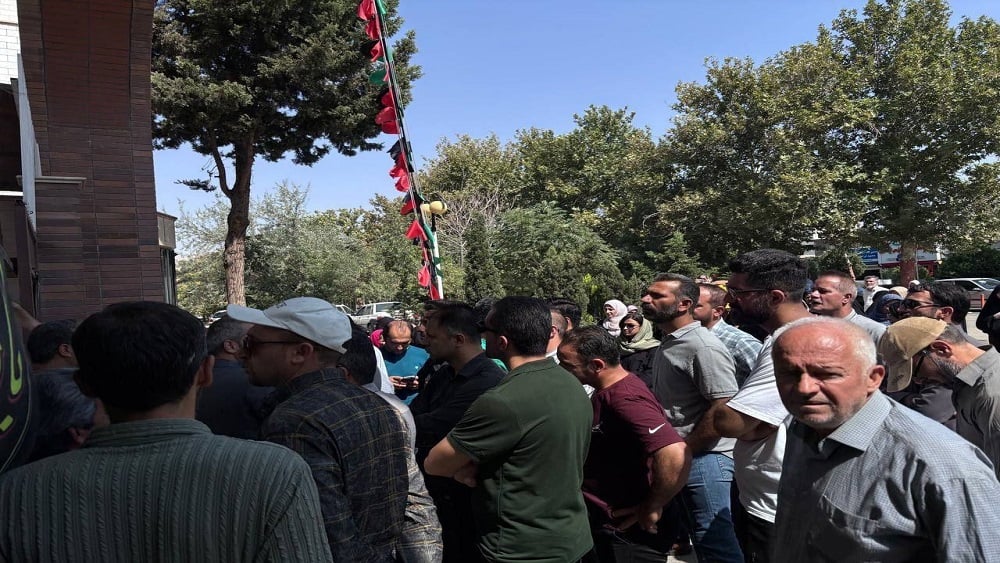Facebook
Twitter
LinkedIn
Pinterest
Reddit
Email
Print
 National housing movement sparks protests over delays and corruption – Shahrud, July 27, 2025
National housing movement sparks protests over delays and corruption – Shahrud, July 27, 2025
A wave of protests swept across Iran on July 26 and 27, revealing the deepening cracks in a regime overwhelmed by systemic failure. From the capital Tehran to cities across the country, citizens from all walks of life—retirees, teachers, farmers, and housing applicants—took to the streets in a unified cry against economic destitution and state corruption. In Rasht, the sentiment of a nation was captured in a single, powerful chant: “The poverty line has risen, our table has shrunk.”
These are not disparate events but interconnected symptoms of a terminal crisis. While the Iranian people demand their fundamental rights, the regime responds with lethal force, and its own state-affiliated media now openly warns of an impending social explosion fueled by its catastrophic policies.
July 27—Rasht, northern Iran
Retires hold protest rally to reiterate their demands for improved living conditions and full implementation of pension harmonization.
Protesters chant, “The poverty line has risen, our table has shrunk.”pic.twitter.com/XNyYx1tK0s
— People’s Mojahedin Organization of Iran (PMOI/MEK) (@Mojahedineng) July 27, 2025
A Nation United in Protest: The Breadth of the People’s Outcry
The protests of late July demonstrated a remarkable breadth of social and geographic scope. In Tehran, Rasht, and Kermanshah, retired social security beneficiaries and teachers held coordinated rallies, demanding an end to the economic hardship caused by the regime’s policies. Their grievances are specific and expose a collapsed system: the failure to implement pension harmonization, chronic delays in payments, and the government’s refusal to settle its massive debt to the Social Security Organization, which would improve retirees’ dire living conditions.
Simultaneously, other sectors of society voiced their outrage. In Kermanshah, farmers gathered to protest the regime’s failure to pay them for their wheat harvests, another broken promise from a bankrupt state. In Shahrud, applicants for the National Housing Movement protested the opaque and corrupt process delaying the delivery of their homes. And in Sabzevar, citizens rallied against chronic electricity and water outages, facing a heavy deployment of security forces whose purpose was clearly suppression, not public service.
July 27—Tehran, Iran
Rally by retired social security beneficiaries and teachers in Tehran, protesting ongoing issues with living conditions, delayed payments, and economic pressures in Iran.#IranProtestspic.twitter.com/JlhhK3tv5w
— People’s Mojahedin Organization of Iran (PMOI/MEK) (@Mojahedineng) July 27, 2025
The Regime’s Answer: Bullets, Not Bread
While citizens peacefully demand their basic rights, the regime’s only response remains brute force. This was starkly illustrated in Helilan, Ilam Province. On the evening of July 23, two young men, Arman Biglari and Pejman Badrivand, were shot and killed by direct fire from regime forces under the command of Supreme Leader Ali Khamenei’s security apparatus.
Their funeral on July 25 was transformed from a ceremony of mourning into a powerful scene of defiance, as a large crowd of mourners turned their grief into a protest, demanding justice and accountability for the murders. The regime has maintained a telling silence on the incident, a standard practice that underscores its utter disregard for Iranian lives and its reliance on terror to maintain its grip on power.
A Regime’s Terrified Confession: An Imminent Uprising
The most damning indictment of the regime now comes from within its own ranks. On July 27, the state-affiliated website Eghtesad News published a panicked report, warning its own officials to “hear the sound of the crisis.” According to the regime’s Central Bank latest reports, an “unprecedented increase in liquidity,” which has surpassed a staggering 10,000 trillion tomans due to “systematic corruption and mismanagement,” has become a severe threat to the country.
July 27—Kermanshah, western Iran
Farmers rally in front of the governorate, protesting delayed wheat payments. Authorities have repeatedly promised to deliver payments but have failed to deliver on their promises.#IranProtests pic.twitter.com/1ULqzUAqPT
— People’s Mojahedin Organization of Iran (PMOI/MEK) (@Mojahedineng) July 27, 2025
Most revealingly, the report explicitly warned that if the regime does not take immediate action, the country will face economic instability and inflation that “will undoubtedly lead to serious livelihood and social protests, not in the long term, but perhaps in the coming months.” This is a direct admission from a source close to the regime that it is fully aware its corrupt policies are driving the nation toward a popular uprising.
The Unraveling of a Tyranny
The events of late July present a clear and undeniable picture: a defiant and organized populace is rising up against a regime that is economically, politically, and morally bankrupt. The scattered protests are merging into a single, powerful river of dissent fueled by decades of repression and corruption. The regime’s fear, now openly broadcast by its own media, is the clearest indicator that the balance of power is shifting. It is a sign that the Iranian people’s unwavering quest for freedom and democracy is gaining irreversible momentum, bringing the day of liberation ever closer.